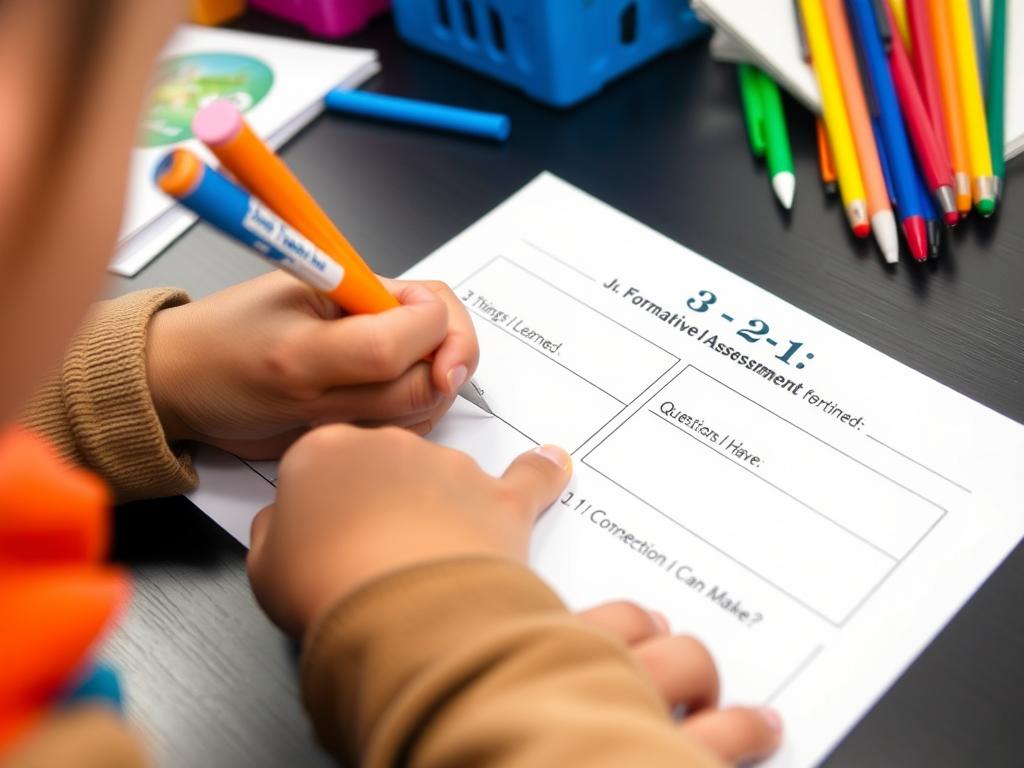In this comprehensive guide, we’ll explore 15 practical formative assessment examples that you can implement immediately in your classroom. These strategies will help you gather meaningful data about student understanding, provide timely feedback, and create more responsive learning environments. Whether you’re new to formative assessment or looking to expand your repertoire of teacher skills, these examples will give you concrete tools to better support your students’ learning journey.
What is Formative Assessment?
Formative assessment refers to a wide variety of methods that teachers use to conduct in-process evaluations of student comprehension, learning needs, and academic progress during a lesson or unit. Unlike summative assessments (like final exams or standardized tests), formative assessments are low-stakes, ongoing processes that help both teachers and students improve.
The primary purpose of formative assessment is to provide feedback that can be used to modify teaching and learning activities. When implemented effectively, formative assessment allows teachers to identify concepts students are struggling with, skills they’re having difficulty acquiring, or learning standards they haven’t yet achieved. This information enables teachers to make immediate adjustments to their instruction.
Research has consistently shown that regular use of formative assessment leads to significant learning gains, especially for struggling students. By developing strong teacher skills in formative assessment, you create more equitable learning environments where all students have opportunities to succeed.
Enhance Your Formative Assessment Skills
Looking to develop your teacher skills in formative assessment? Credits for Teachers offers professional development courses specifically designed to help K-12 educators implement effective assessment strategies.
Benefits of Formative Assessment for Teachers and Students
Before diving into specific examples, let’s examine why formative assessment has become such a crucial component of effective teaching practice:
Benefits for Teachers:
- Provides real-time data to inform instructional decisions
- Helps identify which students need additional support
- Allows for timely adjustments to teaching strategies
- Improves teacher skills in responsive instruction
- Creates opportunities for meaningful student-teacher interactions
Benefits for Students:
- Offers immediate feedback on progress
- Encourages self-assessment and reflection
- Reduces anxiety associated with high-stakes testing
- Promotes a growth mindset
- Increases student engagement and ownership of learning
Implementing a variety of formative assessment strategies helps teachers develop a more comprehensive understanding of student learning while simultaneously building essential teacher skills in differentiation and responsive instruction.

Formative Assessment Examples: Quick Checks for Understanding
Let’s begin with formative assessment strategies that can be implemented quickly, with minimal preparation, to gauge student understanding during instruction.
1. Exit Tickets
Exit tickets are brief written responses that students complete at the end of a lesson before “exiting” the classroom. They provide a quick snapshot of what students learned and identify any areas of confusion.
How to implement: In the last 3-5 minutes of class, ask students to respond to 1-2 questions on a small piece of paper or digital form. Questions might include:
- What was the most important thing you learned today?
- What questions do you still have about today’s topic?
- How confident do you feel about [specific concept]?
This simple formative assessment strategy helps teachers plan the next day’s instruction while developing teacher skills in responsive planning.
2. Think-Pair-Share
Think-Pair-Share is a collaborative learning strategy that gives students time to think independently, discuss with a partner, and then share insights with the whole class.
How to implement: Pose a thought-provoking question related to your lesson. Give students 30-60 seconds to think silently, 2-3 minutes to discuss with a partner, then call on pairs to share their thoughts with the class. This formative assessment approach allows you to circulate and listen to conversations, gathering valuable information about student understanding.

3. Thumbs Up/Down/Sideways
This quick visual check allows teachers to gauge understanding across the entire class in seconds.
How to implement: After explaining a concept, ask students to show their level of understanding: thumbs up (I understand completely), thumbs sideways (I understand somewhat/have questions), or thumbs down (I’m confused). This immediate feedback helps you decide whether to move forward, review, or provide differentiated support.
Developing teacher skills in quick formative assessment techniques like these allows you to maintain instructional momentum while still addressing student needs.
Learn more about implementing formative assessments at Credits for Teachers →
Formative Assessment Examples: Written Responses
Written formative assessments provide deeper insights into student thinking and can be analyzed more thoroughly after class.
4. One-Minute Papers
Similar to exit tickets but more focused on reflection, one-minute papers ask students to quickly respond to specific prompts about their learning.
How to implement: At any point during a lesson, give students one minute to write responses to prompts like:
- What is the most confusing aspect of what we’ve covered so far?
- How would you apply this concept to a real-world situation?
- What connections can you make between this topic and something we learned previously?
5. 3-2-1 Strategy
This structured written response helps students organize their thoughts while providing teachers with multi-layered feedback.
How to implement: Ask students to write:
- 3 things they learned
- 2 questions they still have
- 1 connection they can make to their own lives or previous learning
This formative assessment example helps develop teacher skills in identifying both content mastery and areas needing clarification.

6. Concept Maps
Concept maps are visual representations of knowledge that show relationships between concepts.
How to implement: Provide students with a central concept and ask them to create a map showing how it connects to other ideas, examples, or applications. This formative assessment reveals students’ conceptual understanding and helps identify misconceptions.
Master Written Formative Assessment Techniques
Enhance your teacher skills with professional development focused on implementing and analyzing written formative assessments. Our courses provide practical strategies you can use immediately in your classroom.
Formative Assessment Examples: Digital Tools
Technology offers powerful ways to collect, analyze, and respond to formative assessment data, helping teachers develop advanced teacher skills in data-driven instruction.
7. Digital Polling
Online polling tools allow teachers to quickly gather responses from all students simultaneously.
How to implement: Use tools like Mentimeter, Poll Everywhere, or Google Forms to create quick polls that students can answer via smartphones, tablets, or computers. Questions can range from multiple-choice content checks to opinion surveys that gauge interest or confidence levels.
8. Digital Exit Tickets
Digital versions of traditional exit tickets offer the advantage of automatic data collection and analysis.
How to implement: Create a Google Form, Microsoft Form, or use platforms like Socrative to collect end-of-class responses. Many digital tools will automatically organize student responses, making it easier to identify trends and plan follow-up instruction.

9. Interactive Quizzes
Game-based assessment tools make formative assessment engaging while providing valuable data.
How to implement: Use platforms like Kahoot!, Quizizz, or Quizlet Live to create interactive quizzes that students can complete individually or in teams. These tools often provide immediate feedback to students while giving teachers detailed reports on class and individual performance.
Developing teacher skills in digital formative assessment allows you to collect more comprehensive data while saving time on analysis.
Discover professional development courses at Credits for Teachers →
Formative Assessment Examples: Collaborative Strategies
Collaborative formative assessments leverage peer interaction to deepen understanding while providing teachers with insights into student thinking.
10. Peer Feedback
Structured peer feedback sessions allow students to learn from each other while developing critical thinking skills.
How to implement: Provide students with clear criteria for evaluating each other’s work. The TAG method works well: Tell something positive, Ask a question, Give a suggestion for improvement. As students exchange feedback, circulate to observe their conversations and identify common misconceptions.

11. Gallery Walks
Gallery walks transform the classroom into an exhibition space where students display and review each other’s work.
How to implement: Have students create visual representations of their understanding (posters, diagrams, models) and display them around the room. Students then circulate, examining each other’s work and leaving feedback using sticky notes. This formative assessment approach reveals diverse perspectives while highlighting common themes or misconceptions.
12. Four Corners
This movement-based strategy allows students to physically position themselves according to their opinions or understanding.
How to implement: Label the four corners of your classroom with different responses (Strongly Agree, Agree, Disagree, Strongly Disagree) or answer choices. Pose a statement or question, and ask students to move to the corner that best represents their thinking. Have students discuss their reasoning with others in their corner before sharing with the whole class.
These collaborative strategies help teachers develop essential teacher skills in facilitating productive discussions and analyzing student discourse.
Formative Assessment Examples: Creative Approaches
Creative formative assessments engage different learning modalities and provide alternative ways for students to demonstrate understanding.
13. Visual Representations
Asking students to create visual representations of their learning reveals conceptual understanding in ways that written responses might not.
How to implement: Have students create drawings, diagrams, infographics, or other visual representations that explain key concepts. This formative assessment approach is particularly valuable for abstract concepts or for supporting English language learners.
14. Role Plays and Simulations
Performance-based assessments allow students to demonstrate understanding through action.
How to implement: Ask students to act out historical events, scientific processes, or literary scenes. As they prepare and perform, you can assess their conceptual understanding while they develop deeper connections to the material.
15. Student-Created Questions
Having students generate their own questions reveals their level of understanding and areas of interest.
How to implement: Ask students to create quiz questions about the content you’ve been studying. The complexity and focus of their questions will reveal much about their understanding. You can then use student-generated questions for review activities or future assessments.
Incorporating creative formative assessments into your practice expands your teacher skills while making learning more engaging for students.
Expand Your Formative Assessment Toolkit
Ready to implement these formative assessment strategies in your classroom? Credits for Teachers offers professional development courses that will help you master these techniques and develop essential teacher skills.
Tips for Implementing Formative Assessment Effectively
To maximize the impact of formative assessment on student learning, consider these implementation strategies:
Plan Strategically
Integrate formative assessment into your lesson plans rather than treating it as an add-on. Consider what information you need at different points in the lesson and select appropriate strategies.
Provide Clear Criteria
Ensure students understand what success looks like by providing clear criteria or rubrics. This helps them self-assess more effectively and gives you more meaningful data.
Focus on Feedback
Prioritize giving specific, actionable feedback rather than just scores or grades. Help students understand what they’re doing well and what specific steps they can take to improve.
Remember that developing strong teacher skills in formative assessment is an ongoing process. Start with a few strategies that align with your teaching style and gradually expand your repertoire as you become more comfortable.
Conclusion: Making Formative Assessment Work for You
Formative assessment is not just another educational trend—it’s a powerful approach that transforms teaching and learning by providing ongoing feedback that guides instruction and supports student growth. By incorporating these 15 formative assessment examples into your practice, you’ll develop essential teacher skills while creating more responsive, effective learning environments.
Remember that the goal of formative assessment is not to evaluate or grade students but to gather information that helps both you and your students improve. The most effective teachers use formative assessment continuously, making it an integral part of their instructional approach rather than a separate activity.
As you implement these strategies, you’ll likely find that your teacher skills evolve, your instruction becomes more targeted, and your students become more engaged in their own learning journey. The result? A classroom where assessment truly drives learning forward.
Continue Your Professional Growth
Ready to take your teacher skills to the next level? Credits for Teachers offers comprehensive professional development resources specifically designed for K-12 educators looking to master formative assessment strategies.




